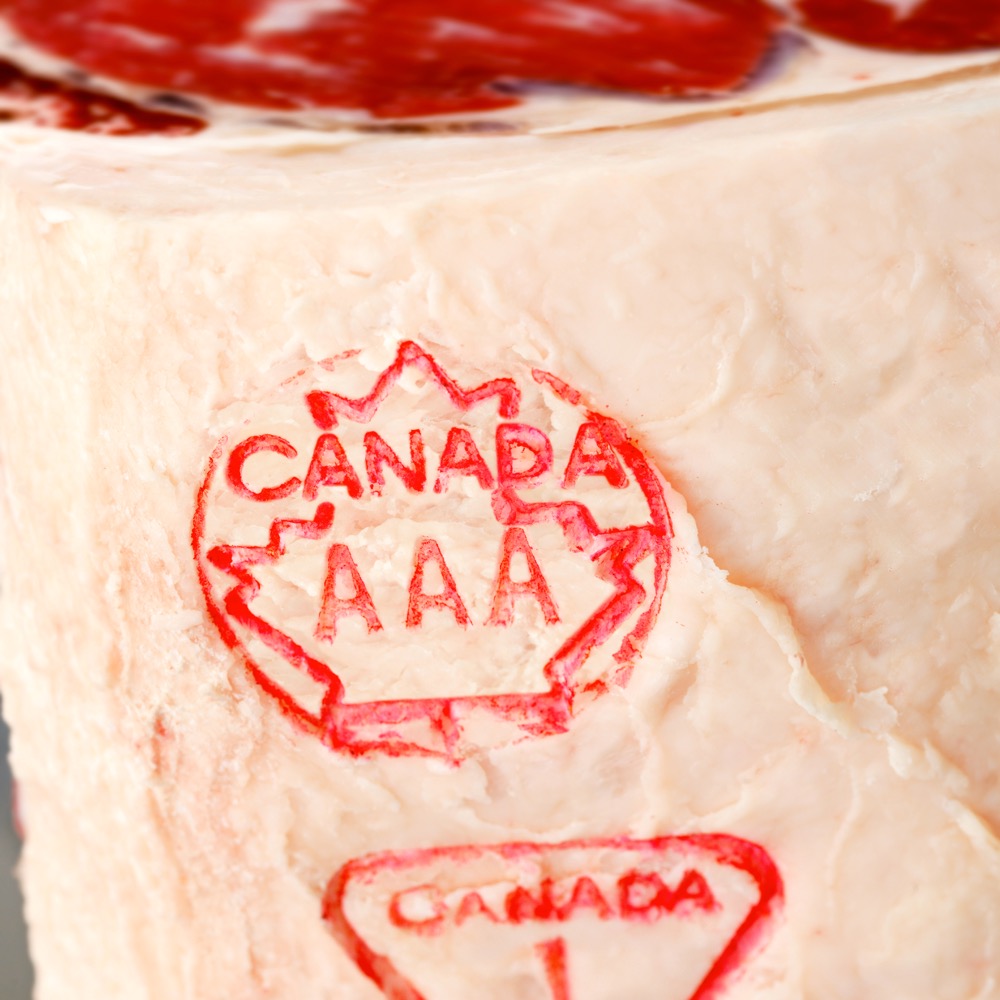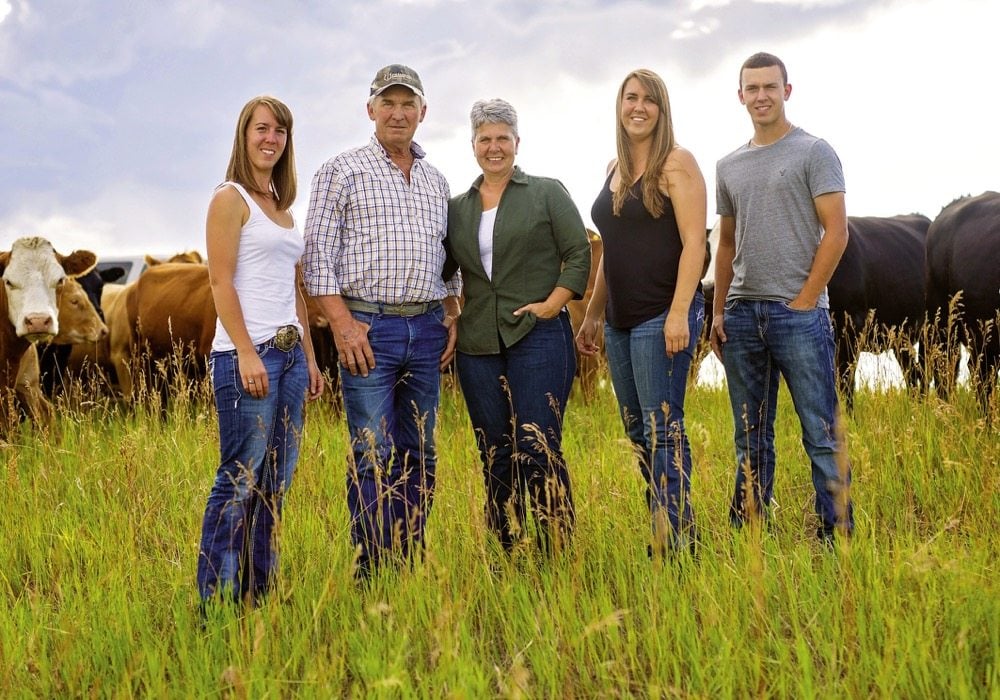You might say that when Vince and Jill Stevenson decided it was time to steer their family’s southwestern Saskatchewan ranch in a new direction, they really went to town with the idea.
The Stevensons are owners of Ranch House Meat Company, a built-from-scratch, 6,000-sq.-ft., full-service meat processing and retail store on Centre Street, Shaunavon, located about an hour and half southwest of Swift Current.
It’s where they sell beef from their 700-mixed breed herd raised on Kerkain Farm, their 10,000-acre ranch. Their animals are slaughtered in a provincially inspected 1,500-sq.-ft. facility they also built on farm three years ago.
Read Also

Riding the tariff rollercoaster
Farmers are accustomed to roller-coaster years. But the current geopolitical windstorm is something else entirely. On his cattle operation near…
Today the Stevensons’ Ranch House Meat Company has helped put their hometown on Saskatchewan’s map of the province’s hottest culinary destinations. It created 10 local jobs, too, and it has built a venue for other local farmers and food producers to sell product, and added an attractive brand new storefront as a focal point in downtown Shaunavon.
Plus, about a dozen restaurants in the southwestern region, including Shaunavon’s own Harvest Eatery, now have Ranch House Meat Company beef on their menus.
“Now that we’ve been here a while, we’ve got an extremely great customer base,” says Vince. (Editor’s note: Associate editor Lorraine Stevenson is not related.)
The power of curiosity
This spring marks the 10th year in operation since opening the doors on the popular meat shop.
Their decision to sell some land and use the proceeds to finance the startup of Ranch House Meat Company came after long deliberation over next steps and the direction they wanted to keep going as beef producers, says Vince. It was made based on a combination of curiosity to do something different and a desire to learn more about their beef’s journey from gate to plate.
“I just wanted to add value to our product,” Vince says.
“Basically, before I started the meat shop we were a cow-calf producer. We would calve in spring and sell our calves in the fall and just take them to the local auction mart and that was it,” he says. “I knew nothing about finishing cattle.”
A lot of reading about trends in the beef industry, from eating quality to production protocols, and consumer demands and preferences, told him it was time to change things up on their farm, but it was during a summer holiday with his family that those ideas began to coalesce around going beyond strictly a cow-calf operation to finishing their own beef and selling it direct to consumer.

“Our family always used to take a holiday around the first of July out to B.C. and it was when we were out there, we wanted to cook up some steaks for supper. I went to a local butcher shop,” says Vince.
He stood in front of the meat case of the shop he was in, and what went through his mind was “if they can do this here, we could do this at home.”
Home is just outside Shaunavon, a corner of rural Saskatchewan their predecessors homesteaded over a century ago. Vince and Jill’s present day operation is a fourth-generation ranch, with a centennial farm sign on the gate a few years already, and the site where his father’s mother’s parents kept a mixed operation going through good and bad years in this land of hard winters and dry summers.
Vince’s father and grandfather were still on the farm when Vince finished high school, so he made his way to college and studied agricultural mechanics, spending about two decades after that working in the oil patch. Through those years he stayed involved with the farm helping with the grain side of the operation, but his main love was the cattle.
He and Jill eventually met and married, and lived a few years in Shaunavon before moving to the farm themselves. The couple have two children, Kain and Kerigan, and the farm’s name is derived from both their names. Both are currently in their early 20s and in college.
The right choices
The story of Ranch House Meat Company’s beginnings is a tale of self-directed education, and bringing their new know-how together within a fully integrated operation.
Vince began to learn about finishing their 700-plus beef herd, and about herd genetics, and he began devising a pasture-to-plate system to ensure they would have slaughter-ready cattle year-round for the store.
The Stevensons also developed collaborations with other regional meat producers including beef and pork to supply the meat shop, and began construction of their own small slaughter plant.

They launched a protocol, too, to communicate with customers how their animals are raised, including what they were fed, and the low-stress methods used to handle them.
“We try to raise them as natural as we can,” Vince says. “We’re not organic. We treat our cattle if they need to be treated and they get all the mineral they want, and their vaccination shots when needed,” he says. For handling, he says, they try to use horseback as much as possible, occasionally using a quad or side-by-side.
Jill designed the attractive storefront of Ranch House Meat Company and its 1,000-sq. ft. of retail space area within, while staff with Saskatchewan Food Industry Development Centre helped them design the rest of the interior’s layout, including its hanging cooler with capacity for about 40,000 lbs. of product. They are frequently complimented on the appearance of the store.
Inside it are a team of dedicated staff they hired locally, plus several trained meat cutters recruited from the Philippines who have since moved their families to Canada and settled in Shaunavon.
Their staff of 10 is divided between those who look after the store, and three or four who staff the slaughter plant.
As the business of Ranch House Meat Company progressed, Stevenson was also educating himself about different beef breeds, too. Theirs is a mixed herd, in which he continues to crossbreed Simmental, Red and Black Angus, Gelbvieh and even some Wagyu, but he’s also introduced Speckle Park, a breed that originated in Saskatchewan. A monument stands along the highway at Maidstone, Sask., in recognition of the family that began the breed.
What breed is that?
A friend drew his attention to Speckle Park, says Vince.
“He knew I had a meat shop and he was always telling me he’d been watching carcass competitions at Calgary Stampede and that Speckle Park has won them,” he says. He bought a few animals from another producer near Lloydminster and discovered a highly efficient feed converter well-suited to a Saskatchewan’s extremes of heat and cold. The breed also produces a nice-sized medium carcass that packs on a lot of tender, marbled meat, he discovered.
“We started with three or four and then we started looking to find people that produce it. The rest is history. Now we basically have 500 or 600 head with Speckle Park breeding in it.”
Speckle Park cattle are as western Canadian as they come and are only the second breed of beef cattle in Canada to be granted distinct breed status. The distinctively colour-patterned cattle are a combination of British breed genetics, the Teeswater Shorthorn, Aberdeen Angus and English cattle with the white park pattern. They came into existence in the early 1960s after being consistently bred to black Angus and on July 6, 2006, the Canadian Speckle Park Association’s Articles of Incorporation were amended to the effect that Speckle Park became a distinct breed of purebred cattle according to the terms of the Canadian Animal Pedigree Act.
It’s a big part of what became so interesting to him as he began to steer the farm operation away from being strictly cow-calf, he says.
“You learn so much by finishing your own cattle. I just can’t stress that enough,” Vince says. “I’ve finished probably a half dozen breeds, and I think they all have their strengths, but I changed my breed of choice to what I’m using now, just because they finish the way we want them for the consumer. The quality to us has just been the best we’ve had.”
About three-quarters of the fresh and processed beef moving through the retail outlet today comes from their own herd. Other producers also supply the store, and they do business with about 15 other local companies who supply additional products such as cheeses, condiments, pizzas and baked goods. They make their own bacon, ham, sausage and deli meat, and also produce an in-house brand of “heat and eat” meals made on site using locally supplied beef, pork and chicken that has proved very popular.
Keeping adaptable
Vince describes Ranch House Meat Company as quite the different beast today than what he first envisioned.
“That’s how naive and short-sighted I was at the beginning,” he says. “I thought we’d sell mostly beef and a little bit of pork and that’d be it. We soon figured out that you need more than a couple of things to bring folks into your store, though.”
He loves his day-to-day interactions with customers but knows having hired a manager for the store has helped take the business further along.
His manager, Cory Audette, was born in Shaunavon and has great people skills, he says.
“He’s good with the staff and with customers, and loves to cook and knows all the different cuts of meat so he’s very knowledgeable talking about the product.”
This was a meat shop launched to serve a local clientele, and remains so, even as their restaurant trade has picked up in the last couple of years. Locals are their primary customer base but they also do brisk business among the large number of oil field workers living, working and staying in this region of the province.

Tourists are also regular foot traffic through the store, as they come through Shaunavon while visiting the substantial attractions of the region.
Shaunavon’s strategic advantage is its location in the heart of a region rich in historic and natural attractions, including Grasslands National Park and Cypress Hills Interprovincial Park. Saskatchewan’s premier dinosaur destination, the T Rex Discovery Centre, operated by the Royal Saskatchewan Museum, is in nearby Eastend.
Learning every day
A few hundred words here barely describe what it really takes to boot-strap a venture like this.
There’s no question that doing all this came with its share of worries and sleepless nights, but it’s also been extremely rewarding to operate this business, Vince says.
“I’ve learned a lot and I’m still learning every day,” he says. “Small business isn’t easy. But I think we should all work on both sides of the till. I’d never had to do the other part of it, the selling…” he says. “I’ve just appreciated dealing with customers and the different variables of this business.”
What he likes about running the company is that it has enabled the family to be in charge of their own destiny, stay at the forefront of change, and explore new ideas.
“There is no middle man,” he continues. “It’s up to me and our business. It’s up to me to raise beef at an affordable price, and it’s up to me to sell it at a price the consumer can afford. Instead of giving this to someone else to do it for us, we’re doing it ourselves.
“And the big thing for me is I’m pretty proud of where I live and what we do,” he adds.
So, it would seem, are the local and repeat customers of Ranch House Meat Company. The past year was rough on all small business, to say the least, but, like so many more direct-to-consumer, farm-to-table businesses, Ranch House Meat Company saw an uptick in support, as more customers turned to more local sources.
He does wonder what lies ahead, but he’s confident about what things will look like post-pandemic, too.
“We’ve had a lot of support from a lot of people,” he says.
As for five years out, he says, “I would say I would just love to keep growing our customer base and giving people a chance to try our product and see what it’s all about.”















